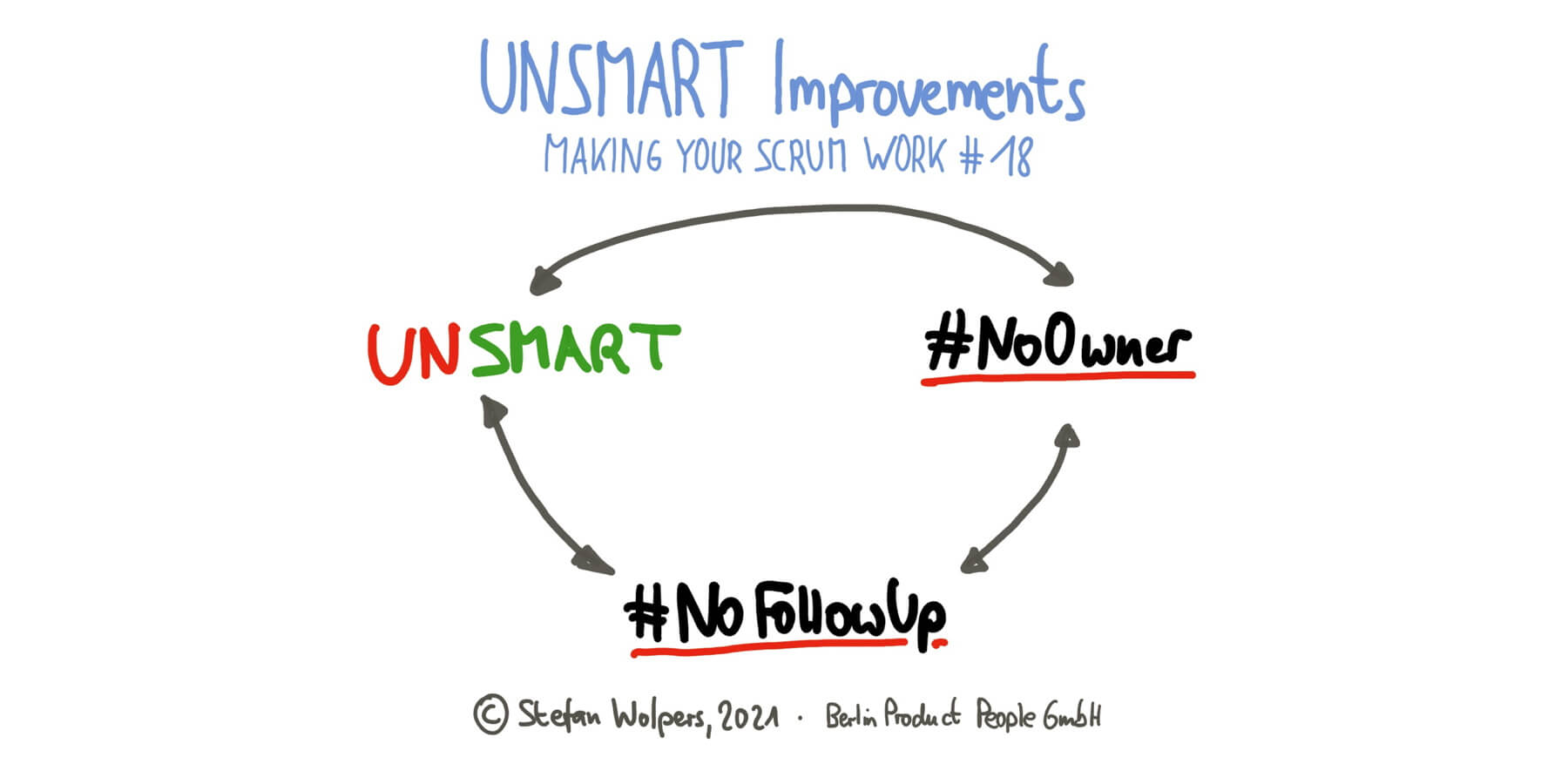UnSMART Improvements at Retrospectives — Making Your Scrum Work #18
TL; DR: Unsmart Improvements
There are plenty of failure possibilities with Scrum. Given that Scrum is a framework with a reasonable yet short “manual,” this effect should not surprise anyone. One area that typically flies under the radar is improvements. While the Scrum Guide encourages addressing the most impactful ones as soon as possible, it is up to the Scrum team to figure out how to improve. One manifestation of this core team task we often encounter is picking unsmart improvements, though.
Join me and delve into the consequences of picking unsmart improvements as a Scrum Team in less than 90 seconds.

🗳 Update: Join the poll on how to deal with unsmart improvement items.
🗞 Shall I notify you about articles like this one? Awesome! You can sign up here for the ‘Food for Agile Thought’ newsletter and join 33,000-plus subscribers.
🎓 Join Stefan in one of his upcoming Professional Scrum training classes!

Sprint Retrospectives According to the Scrum Guide
There are many references to events in general and Retrospectives in particular in the Scrum Guide 2020:
- Page 6: The Scrum Master is accountable for the Scrum Team’s effectiveness.
- Page 6: [Scrum Masters] do this by enabling the Scrum Team to improve its practices, within the Scrum framework.
- Page 10: The purpose of the Sprint Retrospective is to plan ways to increase quality and effectiveness.
- Page 10: The Scrum Team inspects how the last Sprint went with regards to individuals, interactions, processes, tools, and their Definition of Done.
- Page 10: The Scrum Team identifies the most helpful changes to improve its effectiveness..
- Page 10: The most impactful improvements are addressed as soon as possible. They may even be added to the Sprint Backlog for the next Sprint.
Source: Scrum Guide 2020. (The aggregation is taken from the Scrum Guide 2020 Reordered.)
The Scrum Guide 2020 no longer advocates the previous approach: Choose at least one high-level improvement item for the next Sprint; now, it is a suggestion. However, the Scrum Guide does not guide how to accomplish the task at hand.
Manifestations of an Unsuited Improvement Approach
In my experience, three typical anti-patterns prevent a Scrum team from improving its way of working despite pouring money, brain, and time into becoming better at their game:
- The Scrum team picks unSMART actions: Bill Wake created the SMART acronym for reasonable action items: S – Specific, M – Measurable, A – Achievable, R – Relevant, T – Time-boxed. If the team picks unSMART action items, though, it sets itself up for failure. Example: “We want to change the bonus scheme of the company.” Good luck achieving that goal during the next Sprint!
- #NoOwner: No directly responsible individual takes care of an improvement item. (If the “team” is supposed to fix issue X, probably everyone will rely on their teammates to handle it. Find a caretaker instead.)
- #NoFollowUp: The Scrum team does not check the status of the action items from the previous Sprint Retrospectives. (The sibling of autonomy is accountability. If you are not following up on what you wanted to improve before, why care about picking action items in the first place? Do not let the momentum of a successful Retrospect fizzle out that way. )
Cannot see the form?
Please click here
Unsmart Improvements — Conclusion
Every Scrum event is an opportunity for inspection and adaptation. The Sprint Retrospective provides that opportunity to the Scrum Team itself. While the Scrum Guide is no longer prescriptive regarding improvements, it points to the importance of continuously improving as a Scrum team. Hence, avoid standing in your way by picking unsmart improvements.
Have you met a Scrum team choosing unsmart improvements? What happened? Please share your learnings with us in the comments.
✋ Do Not Miss Out: Join the 10,000-plus Strong ‘Hands-on Agile’ Slack Team
I invite you to join the “Hands-on Agile” Slack team and enjoy the benefits of a fast-growing, vibrant community of agile practitioners from around the world.

If you like to join now all you have to do now is provide your credentials via this Google form, and I will sign you up. By the way, it’s free.
📖 Unsmart Improvements — Related Posts
Skipping Retrospectives? — Making Your Scrum Work #17
Scrum First Principles — How to Elon Musk the Scrum Guide
The Blame Game Retrospective — Making Your Scrum Work #6
Three Essential Agile Failure Patterns in 7:31 Minutes—Making Your Scrum Work #12
21 Sprint Retrospective Anti-Patterns Impeding Scrum Teams
Download the Scrum Anti-Patterns Guide for free.
📅 Scrum Training Classes, Workshops, and Events
You can secure your seat for Scrum training classes, workshops, and meetups directly by following the corresponding link in the table below:
See all upcoming classes here.

You can book your seat for the training directly by following the corresponding links to the ticket shop. If the procurement process of your organization requires a different purchasing process, please contact Berlin Product People GmbH directly.
Tags: Retrospective, Scrum Anti-Patterns, Sprint Retrospective